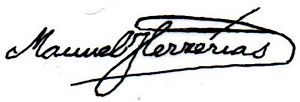Signatories of the Banco Occidental de México
Gerente
|
Alejandro Valdés Flaquer was born in Veracruz on 23 December 1859. He was appointed the first manager of the Banco Nacional de México branch in San Juan Bautista, Tabasco when it opened on 15 October 1896El Tiempo, 23 October 1896; La Patria, 23 October 1896; El Correo Español, 23 October 1896 and was then manager of the branch in Mazatlán. He took over the Banco Occidental de Mexico in 1900. In April 1910 Valdés Flaquer became Director Gerente of the branch of the Banco Nacional de México in Mazatlán, passing the management of this bank to Federico Goodchild who had just come back from EuropeLa Gaceta de Guadalajara, 17 April 1910. He died in Monterrey, Nuevo León, on 17 June 1932. He signed the notes dated from 1900 to 1910. |
 |
|
Fred (Federico) Goodchild, of English origin, was the first president of the board. He was named as manager on 2 February 1898Memorias de las Instituciones de Crédito correspondientes a los años 1897-1898-1899, tomo I and signed some $5 notes dated 1898. He was also manager from 1910 to 1913 and signed notes dated 1913. |
 |
Consejero
|
Bernardo Huthoff was a German merchant and partner in the important Mazatlán firm of “Wöhler, Bartning y Sucesores”the other members were fellow Germans Julio Bartning and Alfredo Wöhler and the Spaniard, Pantaleón Ezquerra. He was also on the board of the Compañía Naviera del Pacifico in 1904El Tiempo, 9 April 1904 and manager of the Sindicato Azucarero in Sonora in 1907El Demócrata, 23 December 1907. Huthoff was treasurer of the Cámara de Comercio de Mazatlán for 1895El Economista Mexicano, 19 January 1895. He signed notes dated 1898. |
 |
|
José Somellera Rivas was related to the powerful Fernández Somellera family of GuadalajaraThe brothers Manuel, Ramón and Agapito Fernández Somellera were born in the town of Limpias, in the province of Santander (Spain). They arrived in Guadalajara around the beginning of the 1840s and engaged in mercantile business individually and independently, but after a few years, on 1 August 1853, they formed the company "Fernández Somellera Hermanos". With this company the Fernández Somellera quickly became partners and enablers of merchants from other cities. In 1885 they established a commercial house in Guanajuato together with Manuel de la Cueva. Towards 1861, together with the Spaniards Joaquín González and José Rivas, they were equal owners of the Portal de San Miguel in the centre of Guadalajara. His father, José Somellera, was a cocoa merchant from the port of Mazatlán who in 1838 or 1839 married Josefa Rivas Góngora from Tepic (then a cantón of Jalisco). Soon after the marriage they moved to Guadalajara, and then Rasines, Santander, Spain where in 1843 they had their first child, FaustinoFaustino Sommellera emigrated to Guadalajara in the 1860, taking advantage of his family connecgtions. He began his commercial activity in Tepic in the early 1870s. His career was enriched by the mining interests and rustic estates of his maternal family, who had much political influence in Tepic and Mexico City. Until 1908, Faustino effectively served as the legal representative of Tepic's most powerful interests. Until 1884 José and his brother, Manuel, were agents of the firm Fernández Somellera y Compañía in Mazatlán. On 13 June 1884 José and Manuel, with their uncle, Agapito Fernández Somellera, formed a company called "Somellera y Compañía", which was located in the port of Mazatlán, and was in charge of buying the goods that arrived at the port and sending them to Guadalajara. Then, in August 1888, the brothers Juan, José and Manuel, formed a company called Somellera Hermanos, with a share capital of $20,000. In 1898 Somellera Hermanos, together with José H. Rico, Miguel González, Careaga Hermanos, Francisco Álvarez, General Ángel Martínez and Elorza Lejarza y Cía , formed the Compañía de Transporte Marítimo, S.A. with a share capital of $125,000. In 1900 José was Presidente of the Compañía Línea de Navegación del PacificoLa Gaceta Comercial, 28 August 1900. In 1902 this company merged with another to form the Compañía Naviera del Pacífico, S.A., with a capital of $1,084,000, subscribed by Genaro García, Maximino Rivera, José Somellera, Marcelino Herrerías, Bernardo Huthoff and Emilio Philippi. José signed notes dated 1900. He died in November 1904The Mexican Herald, 1 December 1904. |
 |
|
Antonio Echeguren arrived in Mazatlán from San Sebastián, Spain in 1840 and began the family’s fortunes. His sons, Francisco and Pedro Echeguren y de la Quintana established businesses in Mazatlán in the 1860s, even though they continued living in Spain. They quickly became one of the richest families in Mazatlán, owners of various mines — including the fabulously wealthy Guadalupe de los Reyes in Cosalá — businesses, industries and properties. By 1863 they were the owners of the majority of all mining operations in the region. Pedro Echeguren died in 1877 and his inheritance was distributed between his widow Concepción Moreno, his five children and his brother Francisco. Francisco, who had married Plácida Herrerías, held the family business until 1901, when it was transferred to Pedro Echeguren y Herrerías. The Echeguren businesses included La Mercería Nueva (the new haberdashery), Almacenes Echeguren (warehouses), the Guadalupe de los Reyes mining companies, La Fundición de Sinaloa, La Fábrica de Hilados y Tejidos Unión (a textile factory) and La Empresa Abastecedora de Agua (water supply), among other companies that employed 17,000 people. They had shares in the Fábrica de Cerveza Pacífico, innumerable real estate properties, and were the managers and builders of the Romero Rubio Market (today known as Pino Suárez). Pedro Echeguren y Herrerías died in 1907. After his death no one wanted to take direct responsibility for the businesses and the family riches that had been built over 50 years soon disappeared. Pedro signed notes notes in 1900. |
 |
|
Bonifacio Lejarza He signed notes dated 1900. In July 1905, along with Somellera Hermanos and others, Bonifacio Lejarza organised the Compañía Minera Piedad y Amparo for the purpose of taking over and developing mines in various parts of SinaloaThe Mexican Herald, 11 July 1905. |
 |
|
Manuel Herrerías was treasurer of the Cámara de Comercio of Mazatlán in 1887El Siglo y Nueve, 14 February 1887. In 1902, two maritime transport companies, the Línea de Navegación del Pacífico, S.A.This company was composed of the fleet of ships that provided the cabotage service owned by the Western Railroad of Mexico, a company established in 1883 by R. R. Symon and Sebastián Camano and managed by George R. Douglas. This company had within its fleet the following steamships: Manzanillo (476 tons), Guaymas (437 tons), Altata (111 tons) and Porfirio Díaz (80 tons). These vessels became the property, in 1901, of the Pacific Navigation Line, S.A., whose capital amounted to $400,000.} and the Compañía de Transporte Marítimo, S.A.The Compañía de Transporte Marítimo, S.A. was incorporated in 1898, with a capital of $125,000 contributed by José H. Rico, Miguel González, Careaga Hermanos, Francisco Álvarez, General Ángel Martínez, Elorza Lejarza y Cía. and Somellera Hermanos. Its fleet consisted of the steamers Río Yaqui (41 tons, formerly owned by Luis A. Martínez y Cía. of Culiacán), Carmen (127 tons) and Alamos (159 tons). merged to form the Compañía Naviera del Pacífico, S.A., with a capital of $1,084,000 contributed by merchants Genaro García, Maximino Rivera, José Somellera, Marcelino Herrerías, Bernardo Huthoff and Emilio Philippi. The fleet of this company was made up of the steamships Manuel Herrerías, San Benito, Manzanillo, Altata, Porfirio Díaz (owned by the Pacific Navigation Line, S.A.), Álamos, Unión, Carmen, Yaqui, Limantour (owned by the Compañía de Transportes Marítimos, S.A.) as well as 29 pangas and the tugboats Rosales and Ramón Corral. The “Manuel Herrerías” took funds to the federal troops in Guaymas in March 1914El Correo de la Tarde, Año XXIX, Núm. 9423, 25 March 1914. Herrerías died in Los Angeles, California on 26 December 1909, having gone there for ChristmasMemoria de las Instituciones de Crédito, 1909: La Iberia, 12 January 1910. He signed notes dated 1900 to 1906. |
 |
|
He signed notes dated from 1900 to 1906. |
 |
|
Guillermo Haas de la Vega was the son of a German soldier, August Haas, and nephew of Rafael de la Vega, a member of the family that had governed Sinaloa until the middle of the 19th century. He was owner of the Hotel Central and the Nuevo Mundo stores, and in 1895 planted cane fields and established a sugar mill at El Roble. He signed notes dated from 1900 to 1913. |
 |
|
[ ] Farias He signed $1,000 dates 1 June 1901. |
 |
|
Víctor José Francisco Patrón Hernández was born in Bilbao, in the Basque region of Spain, on 17 October 1869, the son of Juan Bautista Patron Landeta and Anselma Leonarda Hernandez Gorrita (1834-1885), and with his two brothers was taken to Mazatlán by his uncle, Juan Bautista Hernández Gorrita, between 1890 and 1892. He went to work for Hernández, Mendía Sucesores and over time, as a member of that company, served on the board of various companies in Mazatlán and was president of the Cámara de Comercio in 1904. He was president of the bank for three years and signed notes dated 1913. Later he lived in the United States for almost twenty years, from where he returned to Mazatlán in 1934. He died there in 1962 at the age of 93. |
 |
Interventor
|
Francisco de Sevilla, as Interventor, signed all the notes of the bank, from 1898 to 1913. He was also Tesorero Municipal of Mazatlán in 1908El Tiempo, 5 June 1908. When the revolutionaries captured Mazatlán on 9 August 1914, the last Huertista governor of Sinaloa, General Miguel Rodríguez, fled in the gunboat "Guerrero", accompanied by 97 other people, but the sympathizers and collaborators of the federal forces who were left behind were persecuted by the victors. Francisco de Sevilla was denounced by Oses Cole, the head of the telegraph office (jefe de telégrafos), as a traitor to the revolutionary cause. He was accused for the content of a telegram that he had sent to his sister at the end of the decena trágica in February 1913, more than half a year earlier. De Sevilla had written “I celebrate the end of the tragedy with the results they say it has. Vile action committed by Madero, I suppose him insane, God protect our beloved homeland. I very much want to know about you. (Celebro fin tragedia con resultados dicen tiene. Vil acción cometida por Madero, supóngolo demente, Dios proteja a nuestra querida patria. Mucho deseo saber de ustedes.)”. After a trial de Sevilla was sentenced to deathEl Correo de la Tarde, Tomo XXIX, Núm. 9,530, 12 October 1914. Dozens of telegrams and letters which were sent to Carranza, Madero's widow and the military officers responsible for the case, pleading for him, were of no avail and he was shot on 15 October 1914 . |
 |
